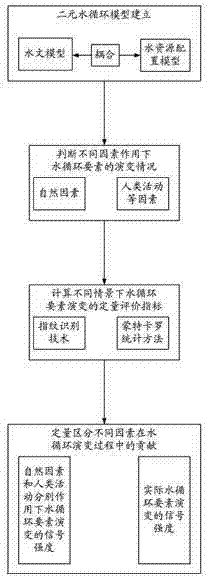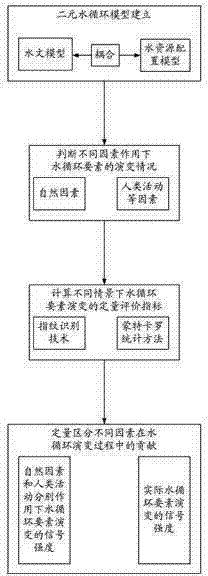Method for quantificationally distinguishing contributions of different factors in water cycle evolution process
A technology of evolution process and water cycle, applied in special data processing applications, instruments, electrical digital data processing, etc., can solve problems such as unconsidered, unable to quantitatively distinguish natural factors, etc., and achieve the effect of enriching theory and research methods
- Summary
- Abstract
- Description
- Claims
- Application Information
AI Technical Summary
Problems solved by technology
Method used
Image
Examples
Embodiment 2
[0041] This embodiment is an improvement of the first embodiment, and is a refinement of the hydrological model in the first embodiment. The hydrological model described in this embodiment is the WEP-L model.
[0042] The WEP-L model described in this example is a model that can not only better simulate natural water cycle processes such as "precipitation-evaporation-infiltration-flow generation-confluence-groundwater movement", but also simulate "water intake-water consumption-water consumption- Distributed hydrological model of artificial collateral water cycle processes such as drainage" (Jia Yangwen et al., 2005).
Embodiment 3
[0044] This embodiment is an improvement of the above embodiment, and is a refinement of the water resource allocation model of the above embodiment. The water resource allocation model described in this embodiment is the ROWAS model.
[0045] The ROWAS model described in this embodiment is based on the generalization of the water resource system, establishes a set of simulation calculation processes controlled by rules for the main elements and processes involved in the water resource system, and designs system water supply based on norms and decision-making procedures. , water use, water consumption, drainage, and operation scheduling of water conservancy projects, and control each link through parameters, and then combine the natural water cycle and artificial collateral water cycle as a whole to study the water resource allocation model (You et al., 2005; You Jinjun et al. , 2005).
Embodiment 4
[0047] This embodiment is an improvement of the above embodiment, and is a refinement of the above embodiment on the climate model. The climate model described in this embodiment is a PCM model.
[0048] The climate model PCM (Washington, 2000) described in this example has a higher resolution in ocean and sea ice simulation, and the simulated physical process is more realistic, and can better simulate the actual climate scenario and climate The global climate model of natural variability, PCM has corresponding forcing experiments that can reflect natural variability, natural factors such as solar activity and volcanic eruptions, and precipitation and temperature conditions under the conditions of climate warming caused by greenhouse gas emissions.
PUM
 Login to View More
Login to View More Abstract
Description
Claims
Application Information
 Login to View More
Login to View More - R&D
- Intellectual Property
- Life Sciences
- Materials
- Tech Scout
- Unparalleled Data Quality
- Higher Quality Content
- 60% Fewer Hallucinations
Browse by: Latest US Patents, China's latest patents, Technical Efficacy Thesaurus, Application Domain, Technology Topic, Popular Technical Reports.
© 2025 PatSnap. All rights reserved.Legal|Privacy policy|Modern Slavery Act Transparency Statement|Sitemap|About US| Contact US: help@patsnap.com



